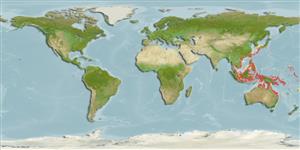>
Tetraodontiformes (Puffers and filefishes) >
Monacanthidae (Filefishes)
Etymology: excelsus: Name meaning 'elevated', referring to it prominently elevated dorsal and ventral profiles..
Environment: milieu / climate zone / depth range / distribution range
Ökologie
seewasser riff-verbunden; tiefenbereich 8 - 25 m (Ref. 90102). Tropical
Western Pacific: northern Australia to southern Japan.
Length at first maturity / Size / Gewicht / Alter
Maturity: Lm ?, range 2 - ? cm
Max length : 2.5 cm TL Männchen/unbestimmt; (Ref. 2334)
Kurzbeschreibung
Morphologie | Morphometrie
Rückenflossenstacheln (insgesamt): 2; Rückenflossenweichstrahlen (insgesamt): 22-24; Afterflossenweichstrahlen: 20 - 22; Wirbelzahl: 20. Diagnosis: Extremely small size at maturity (1.5 cm SL). Prominently elevated dorsal and ventral profiles. Extremely long bristles on caudal peduncle of male, projecting posteriorly to behind middle of caudal fin. Low fin ray counts (D.22 to 24; A.20 to 22; P.10) (Ref. 35708).
Inhabits sheltered coastal habitats, usually in areas with mixed low reef and sparse seagrass (Ref. 48637).
Life cycle and mating behavior
Geschlechtsreife | Fortpflanzung | Ablaichen | Eier | Fecundity | Larven
Randall, J.E., G.R. Allen and R.C. Steene, 1990. Fishes of the Great Barrier Reef and Coral Sea. University of Hawaii Press, Honolulu, Hawaii. 506 p. (Ref. 2334)
IUCN Rote Liste Status (Ref. 130435)
Bedrohung für Menschen
Harmless
Nutzung durch Menschen
Mehr Information
ReferenzenAquakulturAquakultur ProfilZuchtlinienGenetikElectrophoresesVererbbarkeitKrankheitenVerarbeitungNutrientsMass conversion
PartnerBilderStamps, Coins Misc.LauteCiguateraGeschwindigkeitSchwimmstilKiemenoberflächeOtolithsGehirngrößeSehfähigkeit
Tools
Zusatzinformationen
Download XML
Internet Quellen
Estimates based on models
Preferred temperature (Ref.
123201): 25.2 - 29.3, mean 28.6 °C (based on 1897 cells).
Phylogenetic diversity index (Ref.
82804): PD
50 = 0.6250 [Uniqueness, from 0.5 = low to 2.0 = high].
Bayesian length-weight: a=0.01995 (0.00943 - 0.04220), b=2.93 (2.75 - 3.11), in cm total length, based on LWR estimates for this (Sub)family-body shape (Ref.
93245).
Trophic level (Ref.
69278): 3.0 ±0.4 se; based on size and trophs of closest relatives
Widerstandsfähigkeit (Ref.
120179): hoch, Verdopplung der Population dauert weniger als 15 Monate. (Preliminary K or Fecundity.).
Fishing Vulnerability (Ref.
59153): Low vulnerability (10 of 100).
